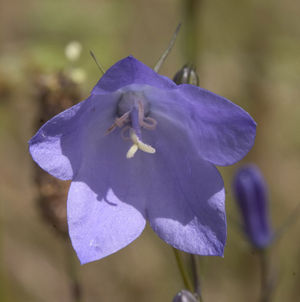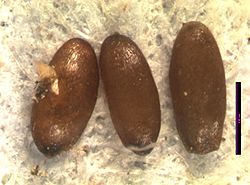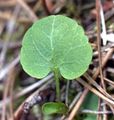Difference between revisions of "Campanula rotundifolia"
(→Description) (Tag: VisualEditor) |
|||
| Line 32: | Line 32: | ||
Leaves: Basal leaves long-petiolate, the blades highly variable, from broadly ovate to cordate-rotund or oblanceolate, entire or toothed, up to 2 cm. long; cauline leaves alternate, fairly numerous, broadly linear, 1.5-8 cm. long. | Leaves: Basal leaves long-petiolate, the blades highly variable, from broadly ovate to cordate-rotund or oblanceolate, entire or toothed, up to 2 cm. long; cauline leaves alternate, fairly numerous, broadly linear, 1.5-8 cm. long. | ||
Flowers: Flowers several in a lax raceme, erect or nodding on long pedicels; calyx lobes 5, 4-12 mm. long, entire; corolla bell-shaped, blue, 1.5-3 cm. long, the 5 lobes much shorter than the tube; stamens 5, free from the corolla; style nearly equaling the corolla; ovary inferior. | Flowers: Flowers several in a lax raceme, erect or nodding on long pedicels; calyx lobes 5, 4-12 mm. long, entire; corolla bell-shaped, blue, 1.5-3 cm. long, the 5 lobes much shorter than the tube; stamens 5, free from the corolla; style nearly equaling the corolla; ovary inferior. | ||
| − | Fruit: Capsule 3-celled, nodding, broadly obconic, 4-8 mm. long. | + | Fruit: Capsule 3-celled, nodding, broadly obconic, 4-8 mm. long.<ref name=":0">WTU |
| + | Herbarium, Burke Museum, & University of Washington. Retrieved from http://biology.burke.washington.edu/herbarium/imagecollection/taxon.php?Taxon=Campanula%20rotundifolia</ref> | ||
A delicate perennial with graceful, slender stems, usually in clusters, rising in height from 4-15 in. The stems can be weak so that the entire plant bends over. Its rounded, basal leaves wither early while the narrow, stem leaves remain. Blue-violet bell-shaped flowers hang singly or in clusters along the top parts of nodding, thread-like, mostly unbranched stems that grow in small patches. The nodding, bell-shaped, lavender flowers are borne in loose clusters at stem tips. | A delicate perennial with graceful, slender stems, usually in clusters, rising in height from 4-15 in. The stems can be weak so that the entire plant bends over. Its rounded, basal leaves wither early while the narrow, stem leaves remain. Blue-violet bell-shaped flowers hang singly or in clusters along the top parts of nodding, thread-like, mostly unbranched stems that grow in small patches. The nodding, bell-shaped, lavender flowers are borne in loose clusters at stem tips. | ||
| Line 38: | Line 39: | ||
===Bloom Period=== | ===Bloom Period=== | ||
| − | June - | + | June - September<ref name=":0" /> |
===Distribution=== | ===Distribution=== | ||
| − | Widely distributed throughout Washington; circumboreal. | + | Widely distributed throughout Washington; circumboreal.<ref name=":0" /> |
===Habitat=== | ===Habitat=== | ||
| − | Ecological Setting-Open, rocky areas from low elevations to the sub-alpine. | + | Ecological Setting-Open, rocky areas from low elevations to the sub-alpine.<ref name=":0" /> |
Soil Texture-Sandy, well-drained soils | Soil Texture-Sandy, well-drained soils | ||
Moisture Regime-Dry soils | Moisture Regime-Dry soils | ||
Shade Tolerance-Mostly shade intolerant | Shade Tolerance-Mostly shade intolerant | ||
| − | Successional Status-Early | + | Successional Status-Early<ref>Plants for a Future. Retrieved from https://pfaf.org/user/Plant.aspx?LatinName=Campanula+rotundifolia</ref> |
===Uses=== | ===Uses=== | ||
| Line 59: | Line 60: | ||
SEED PROPAGATION | SEED PROPAGATION | ||
| − | For best results, seeds should be sown inside and not covered after sowing. They should be bottom-watered. These seedlings will germinate quickly but will not flower until the second year. Root cuttings or stem cuttings stuck in damp sand are other propagation methods useful for this species. | + | For best results, seeds should be sown inside and not covered after sowing. They should be bottom-watered. These seedlings will germinate quickly but will not flower until the second year. Root cuttings or stem cuttings stuck in damp sand are other propagation methods useful for this species.<ref>Native Plants of North America. Retrieved from https://www.wildflower.org/plants/result.php?id_plant=caro2 |
| + | </ref> | ||
{| border="1" | {| border="1" | ||
|- | |- | ||
Revision as of 11:48, 25 March 2021
- Scientific Name: Campanula rotundifolia
- Family: Campanulaceae
- Common Names: bluebell-of-scotland, bluebell, roundleaf harebell
- Codon: CAMROT
Contents
Taxonomy
| Scientific classification | |
|---|---|
| Kingdom: | Plantae |
| Subkingdom: | Viridiplantae |
| Phylum: | Tracheophyta |
| Subphylum: | Spermatophytina |
| Class: | Magnoliopsida |
| Order: | Asterales |
| Family: | Campanulaceae |
| Genus: | Campanula L. |
| Species: | Campanula rotundifolia L. |
| Synonyms | |
| |
Description
General: Perennial herbs with a branched system of rhizomes arising from a taproot, the stems 1-8 dm. tall, usually glabrous. Leaves: Basal leaves long-petiolate, the blades highly variable, from broadly ovate to cordate-rotund or oblanceolate, entire or toothed, up to 2 cm. long; cauline leaves alternate, fairly numerous, broadly linear, 1.5-8 cm. long. Flowers: Flowers several in a lax raceme, erect or nodding on long pedicels; calyx lobes 5, 4-12 mm. long, entire; corolla bell-shaped, blue, 1.5-3 cm. long, the 5 lobes much shorter than the tube; stamens 5, free from the corolla; style nearly equaling the corolla; ovary inferior. Fruit: Capsule 3-celled, nodding, broadly obconic, 4-8 mm. long.[2]
A delicate perennial with graceful, slender stems, usually in clusters, rising in height from 4-15 in. The stems can be weak so that the entire plant bends over. Its rounded, basal leaves wither early while the narrow, stem leaves remain. Blue-violet bell-shaped flowers hang singly or in clusters along the top parts of nodding, thread-like, mostly unbranched stems that grow in small patches. The nodding, bell-shaped, lavender flowers are borne in loose clusters at stem tips. The genus name, from the Latin campana (bell), means little bell. The name Harebell may allude to an association with witches, who were believed able to transform themselves into hares, portents of bad luck when they crossed a persons path. In Scotland, another old name for this plant was Witches Thimble. The characteristics of this perennial vary considerably, depending on habitat conditions. Among other common species are the Southern Harebell ([3]), with wider leaves and smaller, white or pale lavender flowers, typical of wet, grassy meadows. The common garden Bellflower ([4]), which frequently escapes from cultivation, has flowers usually borne on one side of the stems and lanceolate or heart-shaped leaves.
Bloom Period
June - September[2]
Distribution
Widely distributed throughout Washington; circumboreal.[2]
Habitat
Ecological Setting-Open, rocky areas from low elevations to the sub-alpine.[2] Soil Texture-Sandy, well-drained soils Moisture Regime-Dry soils Shade Tolerance-Mostly shade intolerant Successional Status-Early[5]
Uses
Wildlife-Attracts hummingbirds. Bumblebees and swallowtail butterflies visit the campanula flowers Landscaping-Harebell is easily cultured and does well in a variety of sites including rock gardens. Flowers are long lasting. First Nations-Used by a number of different tribes as a ceremonial fumigant Other-Leaves may be eaten raw or cooked.
Propagation
SEED PROPAGATION
For best results, seeds should be sown inside and not covered after sowing. They should be bottom-watered. These seedlings will germinate quickly but will not flower until the second year. Root cuttings or stem cuttings stuck in damp sand are other propagation methods useful for this species.[6]
| FloweringTime | June- Sept |
| Seed CollectionTime | Late July through mid-Sept. |
| Crop Intervals | Perennial |
Fruit/Seed Dormancy and Treatment:No treatment. Seeds may need light for good germination.
Seed
Seed sample from: 2011
Average Measurement: 1 x 0.4 x 0.2
Measurement Range: L: 1 - 1.1, W: 0.3 - 0.5, D: 0.2 - 0.3
Features
Shape: Seeds tapering slightly at hilium end and opposite apex.
Color: Hilium and opposite end are dark brown. The rest of the seed is light brown.
Surface:Seeds longitudinally striate and glossy.
Latitudinal Cross Section: elliptical 
Longitudinal Cross Section: elliptical ![]()
Basic Explanations and Assumptions:
The dimensions for the seeds are length x width x depth. The location of the hilum is used as the base of the seed, and the length is measured from hilum to the opposite apex. Where a style is present, the length is measured from the hilum to the bottom of the style. Width is measured at a right angle to the length at the widest part. Depth is measured at a right angle to the intersection of height and width lines.
Measurements included are the mean average for each measurement of ten separate seeds.
All measurements in millimeters unless otherwise noted.
Photo Gallery
References
- ↑ Integrated Taxonomic Information System. Retrieved from https://www.itis.gov/servlet/SingleRpt/SingleRpt?search_topic=TSN&search_value=34497
- ↑ 2.0 2.1 2.2 2.3 WTU Herbarium, Burke Museum, & University of Washington. Retrieved from http://biology.burke.washington.edu/herbarium/imagecollection/taxon.php?Taxon=Campanula%20rotundifolia
- ↑ C. divaricata
- ↑ C. rapunculoides
- ↑ Plants for a Future. Retrieved from https://pfaf.org/user/Plant.aspx?LatinName=Campanula+rotundifolia
- ↑ Native Plants of North America. Retrieved from https://www.wildflower.org/plants/result.php?id_plant=caro2








